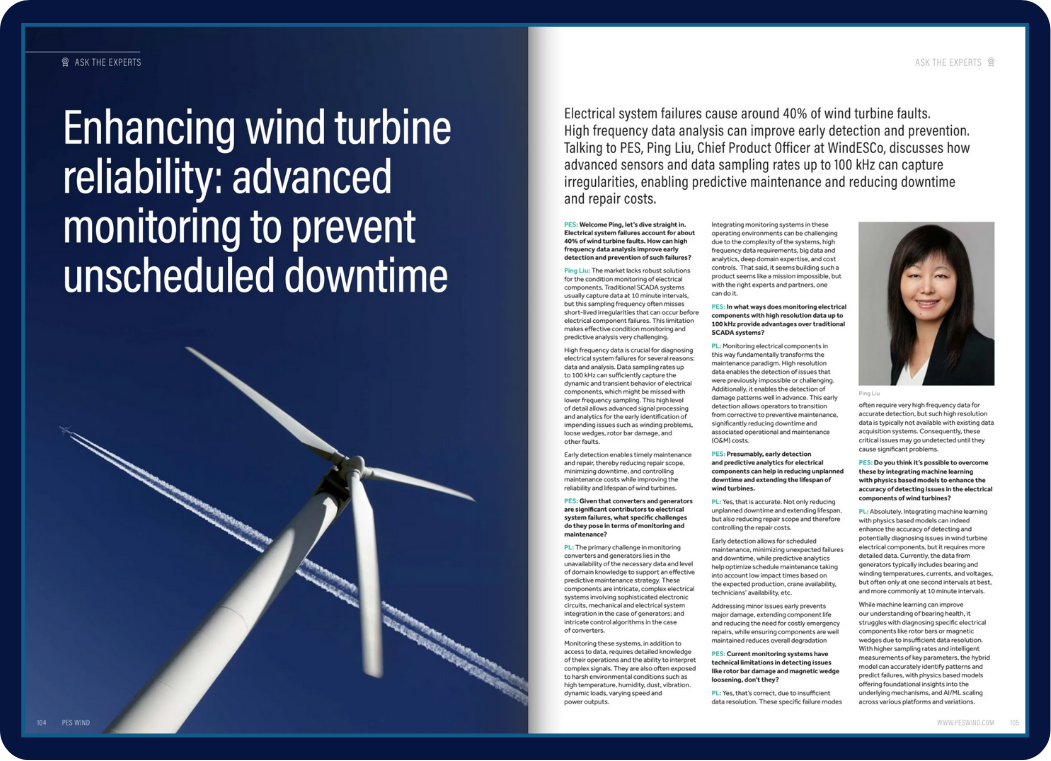Approaches to Data Driven Predictive Maintenance
In this first installment of our blog series: Building a Reliable and Scalable Predictive Maintenance Strategy, we'll introduce two approaches that...

Access to generator, converter, and transformer health data is crucial in both onshore and offshore wind industries. In this blog, we explore the importance of this data, the challenges in monitoring wind turbine components, and how prescriptive analytics is revolutionizing wind plant operations and maintenance.
Wind energy has become a significant source of renewable electricity, with over 70,000 wind turbines deployed across the United States, capable of generating 139GW of clean, reliable electricity. As fleets age and scale, the focus on intelligent operations and proactive maintenance is intensifying. Asset owners and operators are increasingly turning to advanced health monitoring solutions to improve turbine longevity, enhance output, and reduce operating costs.
 Driving Operational Efficiency Through Data
Driving Operational Efficiency Through DataHealth data plays a pivotal role in maximizing turbine performance. By processing vast streams of sensor data from components like generators, converters, and transformers, operators can identify underperformance and inefficiencies. This not only boosts daily energy production but also allows turbines to respond more dynamically in ancillary service markets, supporting grid stability. Over time, this optimization contributes to higher capacity factors and more predictable revenue streams.
Unexpected turbine failures can be incredibly expensive, both in terms of repair and lost production. High-quality health monitoring reduces these risks by providing early warnings of component degradation. It also helps operators plan future capital expenditures and manage warranty claims with greater confidence, ensuring budgets stay on track.
Turbine failures, particularly in offshore environments, pose safety risks and can lead to extended downtimes. Real-time health monitoring enables intelligent diagnostics and rapid mitigation - such as shutting down a turbine at the first sign of a critical fault - to prevent catastrophic damage. This ensures safer working conditions for maintenance crews and keeps turbines operating reliability in challenging environments.
While health data isn essential for optimizing turbine performance, collecting, managing, and interpreting that data presents its own set of complex challenges. Monitoring wind turbine components at scale - in real time and under varying environmental conditions - requires robust systems capable of processing vast amounts of information, filtering noise, and delivering actionable insights.
 The Environmental Challenge: Operating at the Edge of Conditions
The Environmental Challenge: Operating at the Edge of ConditionsWind turbines often operate in harsh and unpredictable environments - from freezing arctic winds to salty offshore air. These conditions can degrade sensors, corrode connectors, and interfere with data transmission. High humidity, dust, vibration, and extreme temperature swings also affect measurement accuracy. Robust, weather-resistant sensor design and redundant communication networks are essential, but even then, real-time validation of sensor data is crucial to avoid false alarms or missed warnings.
As wind plants scale and turbine fleets age, traditional reactive and even predictive maintenance approaches are no longer enough. Prescriptive analytics is stepping in to revolutionize wind plant operation and maintenance (O&M) by not just identifying issues, but also recommending precise actions and optimal timing. This data-driven decision-making capability is becoming a cornerstone for achieving efficiency, reliability, and profitability in both onshore and offshore wind operations.
The complexity and volume of real-time turbine data require more than manual interpretation or basic alarms. Prescriptive analytics platforms continuously process this data, applying machine learning models and scenario simulations to offer specific recommendations - whether it's adjusting turbine settings to mitigate impending icing conditions or temporarily derating a turbine to prevent a generator fault. This empowers operators to respond proactively and confidently in real time, reducing risk and maximizing uptime.
By integrating predictive models with prescriptive logic, operators can move from reactive maintenance to dynamic, optimized strategies. Instead of fixed service intervals, maintenance activities are scheduled based on actual wear indicators, component stress levels, and evolving environmental conditions. For example, if power converter data shows early signs of capacitor degradation, prescriptive analytics can recommend inspection or part replacement during the next low-wind period, minimizing lost production and emergency call-outs. This shift from calendar-based to condition-based maintenance directly improves fleet efficiency and reduces unnecessary expenditures.
 Cost Reduction Through Intelligent Resource Allocation
Cost Reduction Through Intelligent Resource AllocationPrescriptive analytics doesn't just predict failures - it weighs options and provides clear paths forward, factoring in variables like spare parts availability, technician schedules, production forecasts, and even weather windows. By helping operators prioritize interventions and optimize logistics, it reduces costly downtime and prevents over-maintenance. Over the lifecycle of a turbine, these incremental savings translate into substantial reductions in both operating expenses and long-term capital investment.
Continuous health data analysis combined with prescriptive recommendations ensures that wind plants operate at peak reliability. Issues that previously went unnoticed until failure - such as subtle generator electrical anomalies or minor transformer insulation degradation - can now be caught early and addressed efficiently. This not only improves turbine availability but also stabilizes energy output, supporting grid commitments and enhancing revenue predictability.
Access to real-time health data from critical wind turbine components - including generators, converters, and transformers - is essential for the wind energy industry's continued growth and long-term success. While challenges in data collection, processing, and environmental resilience persist, the benefits of comprehensive health monitoring are undeniable. Early fault detection, optimized maintenance planning, and operational adjustments made possible through advanced analytics are helping operators extend asset life, reduce costs, and maximize energy production.
As prescriptive analytics continues to evolve, it is set to transform wind plant operations and maintenance - shifting the industry toward more proactive, data-driven decision-making and enabling more efficient, reliable, and cost-effective renewable energy generation. The future of wind energy will be defined by intelligent, automated systems capable of not only detecting issues but also recommending and executing corrective actions in real time.
WindESCo's Electrical Condition Monitoring System (eCMS) is at the forefront of this transformation. eCMS continuously monitors the health of WTG electrical systems, capturing real-time data from generators, converters, and transformers. By analyzing this data in real time, eCMS empowers operators and OEMs to take proactive measures that protect asset performance, reduce unplanned downtime, and safeguard revenue. Through the adoption of eCMS, wind plant operators can enhance profitability while contributing to global renewable energy goals - helping to drive the broader shift toward a cleaner, more sustainable energy future.
Get in touch with our team for your Personalized Cost-Benefit Analysis for WindESCo's eCMS, today!

In this first installment of our blog series: Building a Reliable and Scalable Predictive Maintenance Strategy, we'll introduce two approaches that...

Wind turbines are complex systems where failures in electrical components - such as generators, power converters, power electronics, drives and...

In a recent "Ask the Experts" interview with PES Wind (Issue 3, 2024), our Chief Technology Officer, Ping Liu, discusses how advanced sensors and...